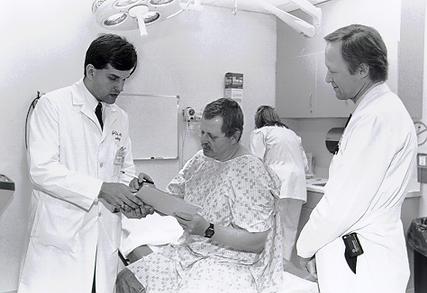Lymphoma clinic brings specialists together to aid patients

Dr. John Zic (left) and Dr John Greer (right) examining patient George Craso at Vanderbilt's cutaneous T-cell lymphoma clinic
Sally Wright, 55, was diagnosed in March 1996 with cutaneous T-cell lymphoma (CTCL), one of the more common non-Hodgkins lymphomas. Three months later, last June, she had her first appointment at VUMC to be treated for the condition. She received good news.
³She¹s at the earliest stage you can be,² said Dr. John A. Zic, assistant professor of Medicine in the division of Dermatology, who, along with Dr. John P. Greer, associate professor of Medicine, conduct a CTCL clinic every other Wednesday in the Dermatology practice area of The Vanderbilt Clinic. The Vanderbilt University Cutaneous Lymphoma Clinic began last July.
³There was an incredible potential to establish a clinic where dermatologists and hematologists could work side by side to manage these patients,² Zic said. He notes that, ³It¹s hard to tell patients they have lymphoma of the skin,² but he was also able to tell Wright that, when caught early, as her cancer was, chances are the cancer will have no effect on her lifespan.
³We did a lot of reading, my husband and I, and we decided to go with Dr. Zic and his recommendations,² Wright said. Those recommendations included the use of nitrogen mustard ointment, which has been proven effective in treating CTCL.
As with most cancers, early detection is the most important element in a cure, but with CTCL, early detection is not always easy.
³The disease is slowly progressive, and early on there may not be enough pathological clues to make a definitive diagnosis,² Zic said. It may mimic other skin problems, such as psoriasis. Even a biopsy may not be definitive early on, because having a few abnormal cells in the biopsy is consistent with other skin problems.
³It¹s not that dermatologists are missing this, but it takes the disease time to be diagnosed with the current technology,² Zic said. In fact, one study showed the lag time between the onset of symptoms and a definitive diagnosis is on average about six years. CTCL often presents as an asympatomatic red patch on a sun-protected area, such as the buttocks.
Most referrals to the clinic come from hematologists and dermatologists, and patients come from all over the region. There is also a tremendous range in the level of disease severity among clinic patients, with some as healthy as Wright, and others nearing an end-stage of the disease.
Another complicating factor is that CTCL is an umbrella term for several conditions, such as mycosis fungoides, Sezary syndrome, and cutaneous anaplastic large cell lymphoma. The clinic also sees patients with cutaneous B cell lymphoma, and related disorders such as lymphomatoid papulosis, follicular mucinosis, and parapsoriasis.
Given both the range of disease types and the range of severity in the patients, the treatements offered can be varied, and can involve a number of other VUMC physicians.
³In this clinic, we end up being the coordinators of care for these patients,² Zic said. ³Patients with early disease, limited to the skin, usually respond to treatment on the skin. When it spreads beyond the skin, we uses systemic treatment–chemotherapy in combination with skin therapy.²
Among the treatment options:
€ Phototherapy. Dr. Michael D. Zanolli, associate professor of Medicine in the division of Dermatology, uses phototherapy to treat CTCL. This involves exposing the skin to ultraviolet rays to fight the cancer, although the precise mechanism by which this works is not known.
³The ultraviolet light causes changes in the skin so that the patient¹s skin becomes able to attack the malignant cells–or perhaps the UVA light is actually toxic to the lymphocytes within the skin,² Zic said. ³We see some dramatic responses.²
€ Nitrogen mustard ointment. This is what proved effective for Wright¹s CTCL. It was the first topical treatment to prove effective against CTCL and was first used in 1947.
€ Total skin electron beam therapy. ³This is good for patients with early stage disease, and is one of the few treatments we have available for patients with large tumors on their skin.²
€ Chemotherapy. This is usually managed by Greer and his associated in Hematology.
€ Photopheresis, in which a patient¹s white blood cells are treated with a UVA light source and reintroduced into the body after the patient has ingested a compound that makes cancer cells susceptible to the treated white blood cells.
For Sally Wright, knowing her treatment is working and that VUMC people are available to her provide comfort.
³I trust what they say. If my cancer comes back, we¹ll start the treatment again.
³I feel fortunate that Vanderbilt is here.²













